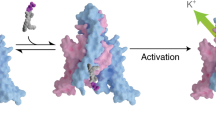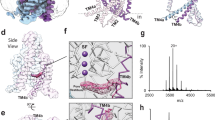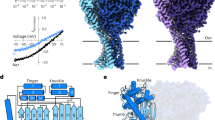Abstract
Hydrolysis of the membrane phospholipid phosphatidylinositol-4,5-bisphosphate (PtdIns(4,5)P2) produces two prospective intracellular messengers: inositol-l,4,5-trisphosphate (InsP3), which releases Ca2+" from intracellular stores1 ; and diacylglycerol (DG), which activates protein kinase C2. Here we show how the formation of these two substances triggered by one external messenger, bradykinin, leads to the appearance of two different sequential membrane conductance changes in the neurone-like NG108-15 (ref. 3) neuroblastoma-glioma hybrid cell line. In these cells bradykinin rapidly hydrolyses PtdIns(4,5)P2 to InsP3 and DG4,5, raises intracellular Ca2+ (refs 4, 6–8) and hyperpolarizes then depolarizes the cell membrane4,8,9. By voltage-clamp recording we show that the hyperpolarization results from the activation pharmacologically-identifiable species of Ca2+-dependent K+ current. This is also activated by intracellular injections of Ca2+ or InsP3 so may be attributed to the formation and action of InsP3. The subsequent depolarization results primarily from the inhibition of a different, voltage-dependent K+ current, the M-current10 that is also inhibited by DG activators. Hence we describe for the first time a dual, time-dependent role for these two intracellular messengers in the control of neuronal signalling by a peptide.
This is a preview of subscription content, access via your institution
Access options
Subscribe to this journal
Receive 51 print issues and online access
$199.00 per year
only $3.90 per issue
Buy this article
- Purchase on Springer Link
- Instant access to full article PDF
Prices may be subject to local taxes which are calculated during checkout
Similar content being viewed by others
References
Berridge, M. J. & Irvine, R. F. Nature 312, 315–321 (1984).
Nishizuka, Y. Nature 308, 693–698 (1984).
Nirenberg, M. et al. Science 222, 794–799 (1983).
Yano, K., Higashida, H., Inoue, R. & Nozawa, Y. J biol Chem 259, 1201–1207 (1984).
Yano, K., Higashida, H., Hattori, H. & Nozawa, Y. FEBS Lett 181, 403–406 (1985).
Reiser, G. & Hamprecht, B. Pflüg Arch ges Physiol 405, 260–264 (1985).
Osugi, T., Uchida, S., Imaizumi, T. & Yoshida, H. Brain Res (in the press).
Higashida, H., Streaty, R. A., Klee, W & Nirenberg, M. Proc. natn. Acad. Sci. U.S.A. 83, 942–946 (1986).
Reiser, G. & Hamprecht, B. Brain Res 239, 191–199 (1982).
Brown, D. A. & Adams, P. R. Nature 283, 673–676 (1980).
Fishman, M. C. & Spector, I. Proc. natn. Acad. Sci. U.S.A. 78, 5245–5249 (1981).
Hermann, A. & Hartung, K. Pflüg. Arch. ges. Physiol. 393, 248–261 (1982).
Adams, P. R., Constanti, A., Clark, R. B. & Brown, D. A. Nature 296, 746–749 (1982).
Marty, A. Trends Neurosci 6, 262–265 (1983).
Lazdunski, M. Cell Calcium 4, 421–428 (1983).
Jenkinson, D. H., Haylett, D. G. & Cook, N. S. Cell Calcium 4, 429–437 (1983).
Hugues, M., Romey, G., Duval, D., Vincent, J. P. & Lazdunski, M. Proc. natn. Acad. Sci. U.S.A. 79, 1308–1312 (1982).
Nohmi, M. & Kuba, K. Brain Res. 301, 146–148 (1984).
Pennefather, P., Lancaster, B., Adams, P. R. & Nicoll, R. A. Proc. natn. Acad. Sci. U.S.A. 82, 3040–3044 (1985).
Kawai, T. & Watanake, M. Br. J. Pharmac. 87, 225–232 (1986).
Yellen, G. Nature 296, 357–359 (1982).
Adams, P. R., Brown, D. A. & Constanti, A. J. Physiol., Lond. 332, 223–262 (1982).
Adams, P. R. & Brown, D. A. Biophys. J. 49, 215a (1986).
Baraban, J. M., Snyder, S. H. & Alger, B. E. Proc. natn. Acad. Sci. U.S.A. 82, 2538–2542 (1985).
Malenka, R. C., Madison, D. V., Andrade, R. & Nicoll, R. A. J. Neurosci. 6, 475–480 (1986).
Madison, D. V., Malenka, R. C. & Nicoll, R. A. Nature 321, 695–697 (1986).
Rane, S. C. & Dunlap, K. Proc. natn. Acad. Sci., U.S.A. 83, 184–188 (1986).
Oran, Y., Dascal, N., Nadler, E. & Lupu, M. Nature 313, 141–143 (1985).
Dascal, N., Lotan, I., Gillo, B., Lester, H. A. Lass, Y . Proc. natn. Acad. Sci. U.S.A. 82, 6001–6005 (1985).
Author information
Authors and Affiliations
Rights and permissions
About this article
Cite this article
Higashida, H., Brown, D. Two polyphosphatidylinositide metabolites control two K+ currents in a neuronal cell. Nature 323, 333–335 (1986). https://doi.org/10.1038/323333a0
Received:
Accepted:
Issue Date:
DOI: https://doi.org/10.1038/323333a0
This article is cited by
-
Cyclic ADP-ribose as an endogenous inhibitor of the mTOR pathway downstream of dopamine receptors in the mouse striatum
Journal of Neural Transmission (2018)
-
Modulation of Kv7 channels and excitability in the brain
Cellular and Molecular Life Sciences (2017)
-
Coordinated signal integration at the M-type potassium channel upon muscarinic stimulation
The EMBO Journal (2012)
-
Protein kinase C may regulate the tonic component of intestinal smooth muscle contraction in response to substance P
Naunyn-Schmiedeberg's Archives of Pharmacology (2004)
-
AKAP150 signaling complex promotes suppression of the M-current by muscarinic agonists
Nature Neuroscience (2003)
Comments
By submitting a comment you agree to abide by our Terms and Community Guidelines. If you find something abusive or that does not comply with our terms or guidelines please flag it as inappropriate.



